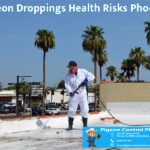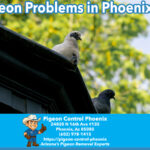Pigeon Droppings Health Risks Phoenix Az : The Hidden Health Threat
As Phoenix parents, we vigilantly protect our children from obvious dangers—swimming pool safety, scorpion awareness, extreme heat precautions. But there’s a health threat many families overlook, despite its prevalence across Metropolitan Phoenix neighborhoods: pigeon droppings and the serious diseases they harbor.
This isn’t a sales message. It’s a public health alert that every Phoenix family deserves to understand, especially as our year-round warm climate creates conditions for continuous pigeon breeding and the exponential increase in contaminated droppings throughout our communities.
The Reality Phoenix Families Face
Pigeon droppings aren’t just unsightly—they’re biohazardous material harboring over 60 transmissible diseases that pose genuine threats to human health, particularly children with developing immune and respiratory systems. When dried pigeon waste becomes airborne through everyday activities like sweeping patios, using leaf blowers, or simply from wind dispersal during our frequent dust storms, family members inhale microscopic particles containing dangerous pathogens.
The risk intensifies in Phoenix because our desert climate allows pigeons to breed 6 or more times annually, compared to just 2-3 breeding cycles in colder regions where winter naturally suppresses reproduction. More breeding means exponentially more droppings accumulating on properties where children play, creating year-round exposure risks that families in seasonal climates simply don’t face.
Three Diseases of Particular Concern for Arizona Families
Histoplasmosis: The Respiratory Threat
Histoplasmosis is a fungal infection caused by inhaling spores from the Histoplasma capsulatum fungus, which thrives in pigeon droppings. This disease particularly threatens children because their developing respiratory systems make them more vulnerable to serious complications.
Early symptoms mimic common flu—fever, cough, fatigue, body aches—leading many parents to dismiss the illness as a typical childhood bug. However, untreated histoplasmosis can progress to severe lung infections requiring hospitalization. Children with asthma or other respiratory conditions face even greater risks, as histoplasmosis exposure can trigger severe attacks or chronic respiratory problems.
The fungus becomes airborne when dried droppings are disturbed. Activities as innocent as children playing near contaminated areas, pets tracking through droppings then entering the home, or wind carrying particles through open windows can expose families to infection risks.
Cryptococcosis: The Neurological Danger
Cryptococcosis, caused by the Cryptococcus neoformans fungus found in pigeon droppings, presents particularly serious risks because the infection can spread from the lungs to the brain and central nervous system. While healthy adults often fight off initial infection, children, elderly family members, and anyone with compromised immune systems face dangerous complications.
This disease is especially concerning for Phoenix families because symptoms can develop slowly and subtly—persistent headaches, confusion, vision problems—that parents might not immediately connect to pigeon exposure. By the time cryptococcosis is properly diagnosed, the infection may have already spread, requiring aggressive antifungal treatments and extended hospitalization.
Salmonellosis: The Food Contamination Risk
Salmonella bacteria thrive in pigeon droppings and can contaminate surfaces throughout your property. The transmission pathway to children is straightforward and frighteningly common: kids play in areas where pigeons roost, touch contaminated surfaces, then eat snacks or meals without properly washing hands.
Phoenix’s outdoor lifestyle intensifies this risk. Backyard play equipment, patio furniture, outdoor dining areas, and pool decks where families spend considerable time can all become contaminated by pigeon droppings. A child climbing on playground equipment beneath pigeon roosting spots, then eating lunch minutes later, faces direct salmonella exposure.
Symptoms include severe diarrhea, fever, and abdominal cramps lasting 4-7 days. Young children and infants face risks of dehydration requiring emergency medical treatment. Chronic complications can include reactive arthritis affecting joints for months following initial infection.

Pigeon Problems in Phoenix Arizona
Why Phoenix’s Climate Amplifies These Risks
Understanding why Phoenix presents unique pigeon-related health risks requires recognizing how our desert environment differs from regions where most pigeon health information originates.
Year-Round Breeding Pressure: In climates with distinct seasons, winter cold naturally reduces pigeon populations through decreased breeding and increased mortality. Phoenix experiences no such natural control. Our mild winters allow continuous breeding cycles, meaning pigeon populations—and their disease-carrying droppings—accumulate relentlessly without seasonal reduction.
Outdoor Living Culture: Phoenix families spend more time outdoors than residents of most American cities. Backyard gatherings, pool parties, patio dining, and outdoor play happen year-round, increasing exposure opportunities to contaminated areas.
Dust and Wind Conditions: Our frequent dust storms and consistent winds easily disperse dried pigeon droppings, carrying microscopic particles into homes through windows, doors, and HVAC systems. Families may face exposure without ever directly encountering visible droppings.
Solar Panel Adoption: Phoenix leads the nation in residential solar installation, inadvertently creating thousands of ideal 8-inch nesting spaces beneath rooftop panels. These hidden nesting areas accumulate massive amounts of contaminated material that homeowners often don’t discover until serious infestations develop.
What Phoenix Parents Can Do to Protect Their Families
Awareness is the first step toward protection. Understanding proper response when you encounter pigeon problems protects your family from exposure risks:
Never Sweep or Pressure Wash Droppings: These common cleanup approaches create airborne clouds of contaminated particles that you and your children can inhale. The particles remain airborne for extended periods, spreading throughout your property and entering your home through open doors and windows.
Keep Children Away from Contaminated Areas: If you notice pigeon droppings on play equipment, patios, or other areas where children spend time, restrict access immediately until professional remediation occurs. Don’t assume rain has “cleaned” the area—dried droppings retain infectious properties even after weathering.
Call Professionals for Proper Remediation: Professional pigeon waste cleanup uses containment protocols, proper personal protective equipment, hospital-grade disinfectants, and safe disposal methods following Arizona Department of Health regulations. This isn’t just about thorough cleaning—it’s about protecting your family from airborne exposure during the remediation process.
Address Pigeon Problems Before They Escalate: Small pigeon problems become large ones quickly in Phoenix’s year-round breeding climate. Early professional intervention prevents the accumulation of contaminated material that creates health risks.
Professional Pigeon Cleanup: Protecting Health, Not Just Appearance
At Pigeon Control Phoenix, our professional pigeon removal and cleanup servicesprioritize your family’s health above all else. Our process reflects 30+ years of experience understanding the unique challenges Phoenix’s climate presents:
Containment First: Before any cleaning begins, we establish containment preventing airborne particles from spreading. This includes sealing adjacent areas and using negative air pressure when necessary for large-scale remediation.
Proper Personal Protective Equipment: Our technicians use respirators, protective suits, and gloves preventing their own exposure—protection that homeowners attempting DIY cleanup rarely employ.
Hospital-Grade Disinfection: We use EPA-approved disinfectants specifically formulated to eliminate the pathogens found in pigeon droppings, not general-purpose cleaners that leave dangerous organisms viable.
Safe Disposal: All contaminated materials are disposed of following Arizona regulations governing biohazardous waste, ensuring community safety.
Pheromone Elimination: Beyond visible cleaning, we treat surfaces to eliminate the chemical markers pigeons use to identify successful roosting and nesting sites, discouraging flock return.
We’re Not Just Protecting Properties—We’re Protecting Phoenix Families
For over three generations, Pigeon Control Phoenix has served Arizona communities with a commitment that goes beyond business—it’s about protecting the families and neighborhoods we call home. When we remove pigeon infestations and remediate contaminated areas, we’re not just improving property appearance; we’re eliminating genuine health threats to children, elderly residents, and vulnerable individuals throughout the Valley.
Our expertise in humane pigeon trapping, permanent exclusion through professional netting and solar panel screening, and comprehensive cleanup means Phoenix families can trust that their bird problems will be solved completely, safely, and with respect for both human health and wildlife welfare.
If you’ve noticed pigeon activity around areas where your children play, don’t delay professional assessment. The free health risk evaluation we provide can identify exposure risks and recommend appropriate remediation before health problems develop.
Pigeon Droppings Health Risks Phoenix Az (602) 978-1415
Text us 24/7 at (602) 786-7386.
Know what the Pigeon Droppings Health Risks Phoenix Az are. Your family’s health is too important to risk with amateur cleanup or delayed intervention. Let Phoenix’s most experienced pigeon control specialists protect what matters most—the people you love.

Pigeon Problems in Phoenix Arizona? Learn Pigeon Droppings Health Risks Phoenix Az



